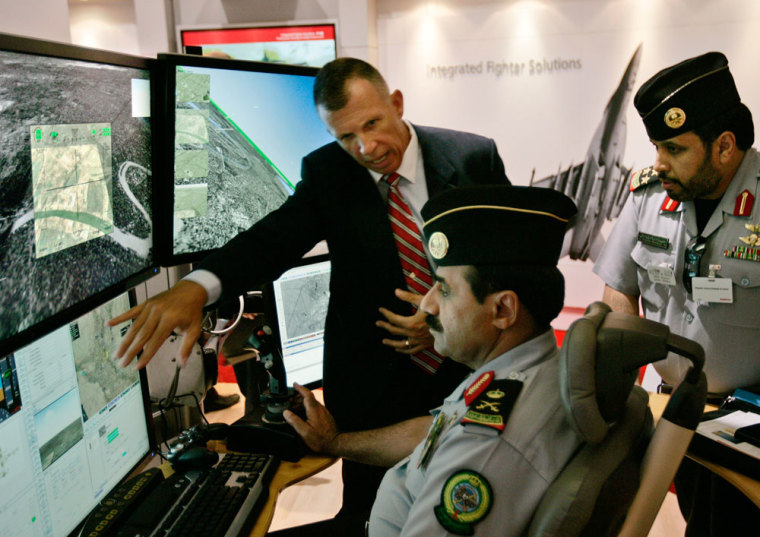It looks like the ultimate new video game: the operator on the comfortable leather chair uses dextrous thumbs on a hand-held console to maneuver an aircraft, whose trajectory is shown on three large flat screens.
But the chair is for a qualified pilot and the landscape on the screen is downtown Baghdad — U.S. defense company Raytheon Inc. is providing a first glimpse of its new control system for unmanned aerial vehicles, or UAVs.
The company says its US$500 million Universal Control System, which uses some hardware from the gaming world, will shorten training time and help prevent crashes of the expensive drones by providing a more interactive experience for the pilot.
"We wanted the human to get into a cockpit and feel they are stepping into the system," said Mark Bigham, director of business development, at the Farnborough International Airshow outside London.
While older stations used just a keyboard, single screen and joystick, a key factor for Raytheon was making the system more intuitive, replacing key strokes with a game console, after talking with experts and discovering thumbs are the most energy efficient and accurate way to control a craft.
The leather chair is fully adaptable to individual users, who can also control a heating and cooling duct above their head at the touch of a switch.
And in a move away from what Bigham calls the "soda straw" view of most pilots of UAVs, the screens are augmented with digital images that provide a near 180-degree view
Other data, such as the health of the craft and where troops are located, is provided on a fourth screen, in much the same way that video games provide extra on-screen information on character health and ammunition levels.
Raytheon, headquartered in Waltham, Massachusetts, is hoping to capitalize on the rapidly growing use of umanned aerial vehicles in both military operations and civil environments around the world — the overall global market is set to go from US$3.5 billion to some US$55 billion in just 10 years, according to the Teal Group.
The war on terror has spurred the use of drones in combat areas, with unmanned aircraft currently flown by the U.S. Air Force and the Royal Air Force in both Iraq and Afghanistan.
BAE Systems PLC announced plans at Farnborough to work with Britain's Ministry of Defense to develop an unmanned aircraft, known as Mantis, that can drop laser-guided bombs and fire missiles.
But the increased use of the drones has highlighted problems with control systems — a Predator crash in Iraq in 2006 was attributed to error by its pilot back in Nevada. Two more recent Predator crashes by the RAF and U.S. Air Force earlier this year have initially been blamed on mechanical problems, but the full reports on the incidents have not yet been published.
The Predators, which are built by General Atomics, are flown by pilots located on a base near Las Vegas. Primarily used for surveillance and reconnaissance, they can also be armed with missiles for hunter-killer missions.
The Federal Aviation Administration says that over two-thirds of Predator UAV crashes are due to human errors interacting with the flight controls. With Predators worth more than US$20 million each, that makes for a costly mistake.
"A lot of things are being attributed to pilot error that should be attributed to poor design," said Bigham, adding that Raytheon believes that its system could reduce costs for the U.S. Air Force by US$500 million over 10 years.
That estimate is based on a combination of reducing the number of crashes and the time spent training pilots to use the system and cutting the number of pilots required to fly fleets of the aircraft.
It hopes at some point to develop the system further so the console, and potentially the chair, vibrates to reflect the sensation of conditions including turbulence and landing.
Raytheon, which has been building its system for the past three years at a cost of "several million" dollars, has been in discussions with both the U.S. Air Force and the Royal Air Force and has hosted several delegations who have shown an interest at Farnborough, including the Saudi International Guard.
For now, Raytheon is focused on military applications. But the system can also be used for marine and civilian applications.
In the United States, Customs and Border Protection is already operating four Predator B drones over the Mexican border, watching for drug traffickers and illegal immigrants.
"People say I'm crazy, but one day we'll see unmanned automobiles," said Bigham. "That's the next big area."
